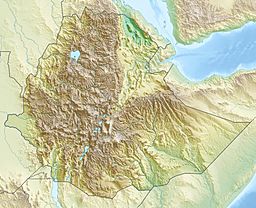Mount Alayta facts for kids
Quick facts for kids Mount Alayta |
|
|---|---|

Alayta in 1999
|
|
| Highest point | |
| Elevation | 1,496 m (4,908 ft) |
| Listing | List of volcanoes in Ethiopia |
| Geography | |
| Geology | |
| Mountain type | Shield volcano |
| Last eruption | 1915 |
Mount Alayta is a 1,496 metres (4,908 ft) shield volcano located in Ethiopia. It produced significant lava flows in the early 1900s. The last time it erupted was in 1915.
Contents
Discovering Mount Alayta
Mount Alayta is a fascinating natural wonder. It stands tall in the Afar Region of Ethiopia. This mountain is not just any peak; it is a volcano. Specifically, it is known as a shield volcano.
What is a Shield Volcano?
Imagine a warrior's shield lying on the ground. That's kind of what a shield volcano looks like!
- They have gentle slopes, not steep, pointy ones.
- This shape comes from very runny lava. This lava flows easily and spreads out far.
- The lava builds up slowly over many eruptions. Each layer adds to the wide, low shape.
- Shield volcanoes are different from cone-shaped volcanoes. Cone volcanoes have thicker lava that piles up quickly.
How Shield Volcanoes Form
Shield volcanoes form over a long time. They are created by many eruptions of fluid lava. This lava comes from deep inside the Earth. It flows out of a central vent or cracks in the ground. Over thousands of years, these layers of cooled lava build up. This process creates the wide, shield-like shape we see.
Where is Mount Alayta Located?
Mount Alayta is found in a very special place. This area is called the Afar Depression. It is part of the Great Rift Valley. The Afar Depression is in northeastern Ethiopia. It is one of the hottest places on Earth. It is also one of the lowest land points.
The Afar Depression: A Unique Place
The Afar Depression is a truly unique geological area.
- It is where three tectonic plates meet. These plates are the Arabian, Nubian, and Somalian plates.
- These plates are slowly pulling apart. This movement causes the Earth's crust to thin.
- When the crust thins, magma can rise closer to the surface. This leads to a lot of volcanic activity.
- Scientists believe this area might become a new ocean. This would happen over millions of years.
A History of Eruptions
Mount Alayta has been active in the past. Volcanoes like Alayta can erupt many times. Each eruption adds new layers of rock.
- The mountain produced large lava flows in the early 1900s.
- Its last recorded eruption was in 1915.
- When a volcano erupts, molten rock, called lava, flows out.
- Lava flows can be very powerful. They can change the landscape around the volcano.
Even though its last eruption was over a century ago, Mount Alayta is still a significant volcano. It reminds us of the powerful forces at work beneath the Earth's surface. Studying volcanoes like Alayta helps scientists understand our planet better. It also helps them predict future eruptions. This knowledge keeps people living near volcanoes safe.


